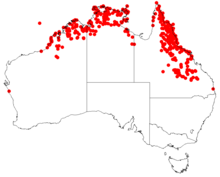Persoonia falcata
| Wild pear | |
|---|---|

| |
| Scientific classification | |
| Kingdom: | Plantae |
| Clade: | Tracheophytes |
| Clade: | Angiosperms |
| Clade: | Eudicots |
| Order: | Proteales |
| Family: | Proteaceae |
| Genus: | Persoonia |
| Species: | P. falcata |
| Binomial name | |
| Persoonia falcata | |

| |
| Occurrence data from Australasian Virtual Herbarium | |
| Synonyms | |
|
Linkia falcata (R.Br.) Kuntze | |
Persoonia falcata, commonly known as the wild pear, is a shrub native to northern Australia.[2]
Taxonomy
The species was first formally described by Scottish botanist Robert Brown in 1810 in his paper, On the natural order of plants called Proteaceae, having been collected at Endeavour River, in what is now north Queensland.[1] Its species name is the Latin adjective falcata "sickle-shaped", from falx "sickle", and refers to the shape of the leaves.
In 1870, George Bentham published the first infrageneric arrangement of Persoonia in Volume 5 of his landmark Flora Australiensis. He divided the genus into three sections, placing P. falcata into the otherwise wholly Western Australian P. sect. Pycnostyles.[3] The 1995 Flora of Australia revision of the genus saw it classified in the Teretifolia group, along with nine species from southwest Western Australia. These species have very short tepals compared with other persoonias.[4]
In their Enindhilyagwa language, the indigenous people of Groote Eylandt call the species awulka. The people of Yirrkala, who use the Rirratjingu language, call it dangapa,[5] and in the Bininj Kunwok language, used by the Bininj people, who live primarily in western Arnhem Land, it is mandak.[6]
Description
Persoonia falcata grows as a woody shrub or small tree, anywhere from 1 to 9 m (3.3 to 29.5 ft) high. The thick dark grey bark is layered and flaky. The pale green-grey leaves are 8–35 cm (3.1–13.8 in) long and 0.4–3 cm (0.16–1.18 in) wide, and oblanceolate to linear-oblanceolate or falcate in shape. The yellow flowers appear from June to November.[7] The yellow-green fruit, known as drupes, appear from October to February. Edible, they are eaten raw by local aborigines.[8]
Distribution and habitat
Persoonia falcata ranges across a broad swathe of northern Australia, generally within 300 km (190 mi) of the coastline.[7] In the northwest of Western Australia it is found in the Great Sandy Desert and vicinity of Broome,[9] eastwards across the Northern Territory into northern Queensland, with the Blackdown Tableland marking the southeastern limit of its range.[7]
It grows along watercourses, gorges and sandstone outcrops, generally on sandstone-based or alluvial soils.[9] It is also found on granite-based and lateritic soils, and rarely clay.[7] It grows in Eucalyptus, Melaleuca, or mixed open woodland communities.[7]
Cultivation and uses
Attempts to grow Persoonia falcata at the Royal Botanic Gardens of Sydney and Melbourne have failed, as plants planted into soil have perished.[4] Aborigines would use a solution infused with wood and bark as an eye wash, and drink an infusion from the leaves to treat chest colds and diarrhoea. Leaves could also be applied to circumcision wounds.[8]
References
- ^ a b "Persoonia falcata R.Br". Australian Plant Name Index (APNI), IBIS database. Centre for Plant Biodiversity Research, Australian Government.
- ^ "Persoonia falcata R.Br". FloraBase. Western Australian Government Department of Biodiversity, Conservation and Attractions.
- ^ Bentham, George (1870). "Persoonia". Flora Australiensis. Vol. 5. London, United Kingdom: L. Reeve. pp. 380–81, 386.
- ^ a b Weston, Peter H. (2003). "Proteaceae subfamily Persoonioideae: Botany of the Geebungs, Snottygobbles and their Relatives". Australian Plants. 22 (175): 62–78. ISSN 0005-0008.
- ^ Specht, Raymond (2006). "Aboriginal Plant Names in Northeastern Arnhem Land: Groote Eylandt - Enindilyakwa Language; Yirrkala - Rirratjingu Language". Australian Aboriginal Studies (1): 63–67. ISSN 0729-4352.
- ^ "Mandak". Bininj Kunwok dictionary. Bininj Kunwok Regional Language Centre Ltd. Retrieved 2021-11-29.
- ^ a b c d e "Persoonia falcata". Flora of Australia Online. Department of the Environment and Heritage, Australian Government.
- ^ a b Brock, John (2001) [1988]. Native plants of northern Australia. Frenchs Forest, New South Wales: New Holland Press. p. 279. ISBN 1-876334-67-3.
- ^ a b "Persoonia falcata". FloraBase. Western Australian Government Department of Biodiversity, Conservation and Attractions.
